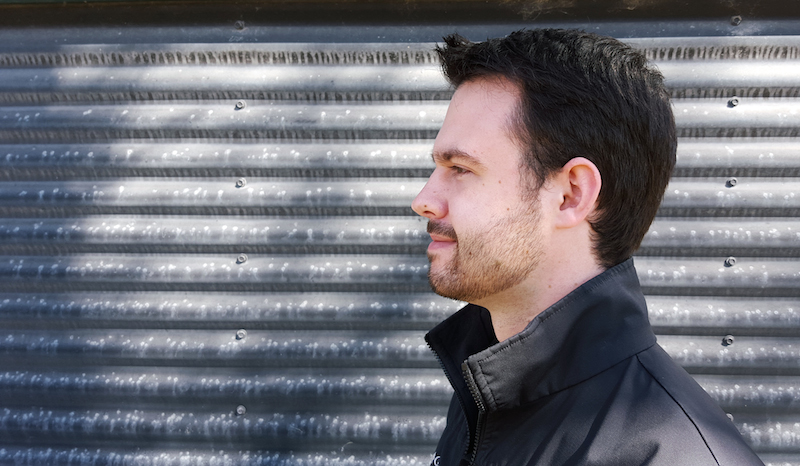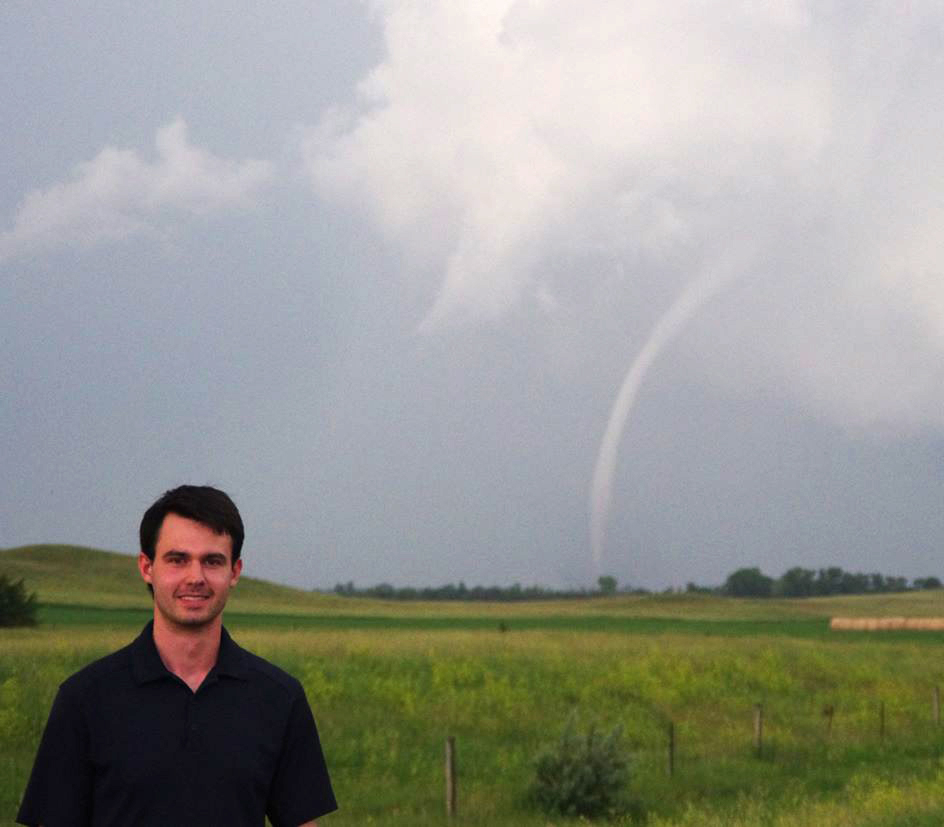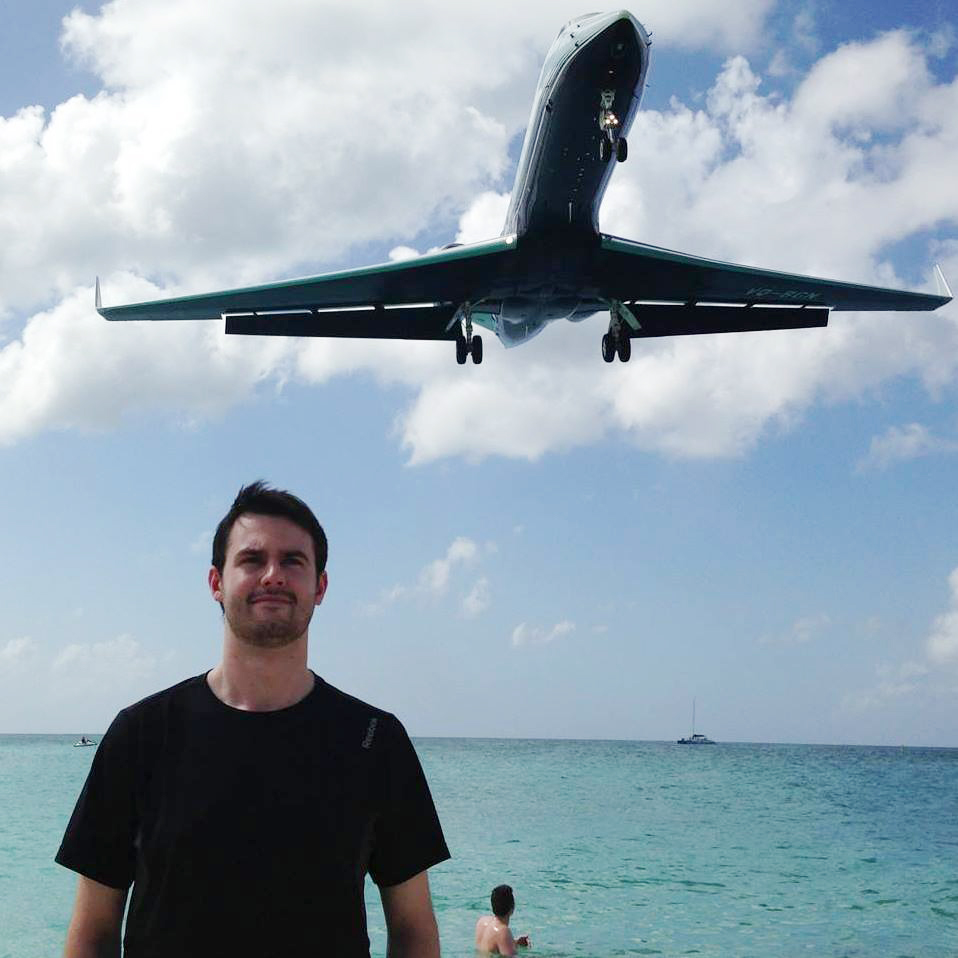
Scott Kehler // Photo: Sean Moore
CANDID: Meet Scott Kehler
Scott Kehler makes your pulse slow down. He speaks with a disarmingly calm and confident cadence. Conversing with him is a relaxing pastime more people should engage in, but he’s busy so don’t knock on his office door. He studies nocturnal thunderstorms and he enjoys chasing tornadoes, but he doesn’t show signs of being an adrenaline junkie. He’s a scientists in training after all. And storm chasing, it turns out, is a mostly uneventful affair.
Kehler is one of one of the roughly 3,800 students enrolled in the University of Manitoba’s Faculty of Graduate Studies and UM Today sat down with him to learn more about how he came here and what cool things he does.
Master’s student: Scott Kehler
Studying in: Department of environment and geography in the Clayton H. Riddell Faculty of Environment, Earth, and Resources
Advisor: John Hanesiak
UM Today: Where are you from?
Scott Kehler: I’m originally from Steinbach but I have been living in Winnipeg for about four years
Did you do your undergrad here too?
Yeah, an honours in physical geography.
Did you look at other schools when deciding on a masters?
Not really because my advisor was doing a field project called PECAN – which stand for Plains Elevated Convection at Night. It was a major US field study about nocturnal thunderstorms and that was something I really wanted to be part of.
What’s special about thunderstorms at night?
Actually thunderstorms are more common at night but we don’t know why. So we undertook this major to project to figure this out
Any answers?
So far there are a few theories, but nothing solid yet. People are just starting to analyze the data from the project so it will be a few years before we see some more definite conclusions.
It’s a big issue because, especially in the US, these storms can be very large and they contribute a huge amount to rainfall to agricultural areas. So we want to understand why these storms are happening at night because they are critical to the agriculture of the region. These storms can also be a significant hazard to lives and property. Nocturnal thunderstorms can produce large hail, damaging winds, and torrential rain.
What could we do with this information?
We can’t stop a storm but producers want to know the climatology of their region so they know what crops to grow. And because thunderstorms are more erratic than other phenomena, it’s important to know the characteristics and trends of them so they can be better predicted, helping to provide advance warning if a dangerous storm is heading for a particular location.
What is it you like about this field of study?
Part of the field that I really enjoy is just getting out there and observing storms. I especially like watching tornadoes. Although that’s not really my area of research at the moment but I do spend some time observing tornadoes and daytime storms.
Is there something cool about thunderstorms that maybe people don’t know?
I think one misconception about thunderstorms is the way they behave. People have a lot of misconceptions about if a tornado is coming, you should go to a certain corner of your basement. But thunderstorms can move in any direction and can change direction. But people seem to assume that thunderstorms follow a certain track.
There was a famous case in the US of where the storm changed directions. You may have heard of the tornado called El Reno. It killed a couple of storm chasers. That storm was famous for changing course mid tract. It was going towards the southeast and then suddenly turned and started heading towards the northeast. And when it made that change the storm chasers got caught off guard and some were killed in that incident.
Have you ever done storm chasing?
Yeah.
What’s that like?
It can be exciting but there is a lot of waiting. Waiting is a huge part of it. If we’re storm chasing we’re lucky if we only have to drive a couple of hours. That would be a good day. The furthest I’ve driven in one day is to Moose Jaw, Saskatchewan, which is about six and half hours from here. So I drove all the way out there because I was anticipating storms and we waited for a while and eventually one formed. We followed it, and then drove back again. So that day we spent about 14 or 16 hours driving. And of that whole 16-hour day we were maybe watching a storm for a few hours.
It’s mostly waiting and driving.
When it’s happening though, is it exciting? Or are you nervous about lighting?
Oh yeah it’s exciting but lightning is probably the second most dangerous aspect of storm chasing. The most dangerous aspect, no question, is the driving. But lightning is so unpredictable—you have no idea where it will strike. Tornadoes can be erratic but you have a general sense of where it’s going. Same with hail—you know what parts of the storm are producing hail and you can avoid it. But lighting can strike anywhere. You just never know where it’s going to happen.
Are your parents scientists?
No, my mom is a retired gym teacher and my dad is a manager at a trucking company.
Have you always been a curious fellow interested in climate and weather?
I’ve always been interested in science and I picked up the weather aspect probably about 10 years ago. Since that time that has been my main focus area. I just enjoy the challenge of it because forecasting weather is a really tough problem. You’re never going to be perfect, so there is always room to improve and learn more.
Do you even bother to pay attention to long-term forecasts?
I actually have some inside information on that. The first two days of Environment Canada’s forecast are produced by the people who work at Environment Canada, and the rest is produced by computer systems. So when I look at the forecasts, well, I mainly do my own forecasting to begin with, but if I look at theirs I really just pay attention to what they are saying for the next day or so because I know someone has examined it.
Frankly, I wouldn’t pay attention to the Weather Network’s 14-day forecast because at that range the computers accumulate so many errors in their calculations that it’s really not reliable.
You mentioned you were always into science, but 10 years ago you got interested in weather. Why? Did you get exposed to something that sparked your interest?
I became very interested in weather around the time of the Elie tornado in June 2007. The Elie tornado was the strongest tornado to ever occur in Canada, and the only F5 tornado in Canada to this day. Since that storm happened so close to home it got me thinking a lot more about weather. From that point on weather forecasting became my main hobby and led me to pursue an atmospheric science degree at the U of M in 2011.
What are your hobbies?
Storm chasing is a big hobby. I’m also involved a lot in politics.
What kind of involvement?
I manage provincial and federal election campaigns for the Liberals.
How did you get involved in that?
The reason I got involved in politics was because I was very unhappy with the direction the country was headed under the Harper Conservatives. I decided that the only way to help change the direction of our government was to get involved. The first election campaign I worked on was the 2008 Federal Election. I have worked on every Federal campaign since, including being a campaign manager for the Liberal Party in the 2015 Federal Election. It was very exciting to see Canadians elect a Liberal government last fall and it was rewarding to know that I had a part in that election.
What did you want to be as a kid?
When I was really young I wanted to be a heavy equipment operator—like driving excavators and big trucks. When I was a bit older, around age 10, I wanted to be an engineer.
If you were on Jeopardy, what would your anecdote be?
I have a lot of weather stories but none that stands out.
Want to tell me a weather story?
The one I talk about the most is a storm chase I did last summer in western Manitoba. A lot of people heard about the tornado that happened by Tilston at the end of July. It was a big story because it was a massive tornado that went through mainly open fields but it attracted storm chasers from all over Canada ad the US. So it was a big deal in our community.
It was the strongest thunderstorm I have ever seen. And I have seen thunderstorms all over Canada and the US. But that storm stood out as being the strongest I have ever witnessed, which was right here in Manitoba. And I think a lot of people overlook how strong our storms can be here. People assume these really strong storms only happen in, say, Oklahoma.
Have you seen the movie Twister?
I have and it annoys me in one sense because people may think it’s somewhat realistic, and it’s not.
If you’re lucky, you’ll see one tornado for every 10 storms you observe.
And these tornadoes aren’t just popping out of nowhere, they take time to develop. You’re generally waiting around for it to happen and develop.
Research at the University of Manitoba is partially supported by funding from the Government of Canada Research Support Fund.











Always great to read of a young person who pursues his or her dream and does well.
Scott answered the questions very well and set a positive example to other students.